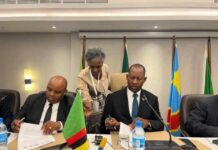PARLIAMENTARIANS in the Southern African Development Community (SADC) have their work cut out for the upcoming plenary assembly session of the Parliamentary Forum in Swaziland in a fortnight following a three-day capacity-building conference in Johannesburg, South Africa, last week.
Convened by the AIDS and Rights Alliance for Southern Africa (ARASA) and the SADC Parliamentary Forum (PF), members of Parliament (MPs) were introduced and briefed about issues in public domain in the region to enable experts and legislators to help shape and inform the outcome of the Plenary Assembly session of the Parliamentary Forum in Swaziland.
SADC PF vice-president Joseph Njobvuyalema said following the parliamentary committees’ symposium on criminalisation and stigmatisation: disincentives to the realisation of fundamental human rights, legislators in the region will form an agenda, debate and refer the matters to their national parliaments.
Besides criminalisation and stigmatisation relating to HIV transmission, abortion and people who use drugs, experts and MPs also discussed the domestic resource mobilisation, living and working conditions in the mining sector being a risk factor for Tuberculosis.
Wilson Box, the project’s executive director at Zimbabwe Civil Liberties and Drug Network, said most SADC member States are using prohibitionist policies that criminalise people who use drugs.
“People who use drugs are stigmatised, discriminated and at times isolated without any help extended to them. Drug users need compassion, love and care,” Mr Box said in his presentation ‘The policy nexus between drug users and HIV/AIDS: A step in the search for a sustainable drug policy in SADC’.
He said most SADC countries do not have harm reduction programmes to assist people who use drugs.
Tanzania is the only country that has publicly introduced the Methadone Programme to treat drug addicts and Mauritius has also assisted People Who Inject Drugs (PWIDs).
Mr Box said in Southern Africa, there is no reliable data on drug users (PWIDS and recreational users) despite the fact that SADC has promised in its 2013 – 2016 programme of action to “make the SADC region safer from crime and drugs”.
He said the United Nations Office on Drugs and Crime has also noted that there is a lack of adequate legislation, policies and programmes on drug use and HIV prevention, treatment and care to people who use drugs.
Mr Box said due to policies that criminalise drug users, the users will not come out in the open to seek treatment on time.
“This is a time bomb that has seen communities being ravaged by HIV/AIDS,” he said.
As a submission to a humane drug policy that puts peoples’ lives first and respects their rights, Mr Box’s organisation has recommended a health-based approach to drug use, which recognises that drug policies should, above all, put people first and respect their human rights.
He said drug policies should have facets such as drug prevention, harm reduction, drug dependence treatment, alternatives to arrest and incarceration as well as access to life-saving essential medicines.
According to United Nations Office on Drugs and Crime (UNDOC), the number of drug users rose from 203 million in 2008 to 243 million in 2012. In closed settings, drug users have contracted TB, HIV and AIDS or Hepatitis B and C.
Global illicit opium production has increased by more than 380 percent since 1980 from 1,000 metric tonnes to over 4,000 today.
Mr Box said the international drug control system is failing to control new psycho-active substances which are fuelling crime and enriching criminals.
The total illicit drug trade stands at US$332 billion today from US$13 billion in 2005.
Kunal Naïk, the communications and advocacy officer for Collectif Urgence Toxida, said needle and syringe programmes are interventions that provide clean needles and syringes to people who inject drugs to decrease the sharing of equipment and consequently reduce HIV transmission.
Mr Naik said the United Nations recommends providing 200 sterile needles and syringes per drug injector per year, in order to effectively tackle HIV transmission.
Discussing criminalisation of termination of pregnancy, Lynette Mabote, the regional TB, HIV and Human Rights Advocacy team leader at ARASA, observed that the persistence of unsafe abortion in Africa is perpetuated by two restrictive laws against termination of pregnancy; and the limited or lack of access to adequate abortion services.
She said of the six million abortions performed in Africa per year, only three percent are performed under safe conditions, and unsafe abortions account for up to 30 percent of maternal deaths in some countries on the continent.
Ms Mabote said annual abortion rates are 29 abortions per 1,000 women aged between 15 and 44 in Africa, saying approximately 29,000 deaths per year are due to complications from unsafe abortions.
According to the World Health Organisation and the African Commission, a further 1.7 million African women are hospitalised yearly due to complications from unsafe abortions.
She said legal restrictions on abortion do not reduce abortion rates.
“Instead of preventing women from seeking abortion, the criminalisation of abortion causes women to turn to illicit and often highly dangerous abortion methods, including the ingestion of toxic solutions, the placement of foreign bodies into the uterus, which cause severe trauma,” Ms Mabote said.
She added that where laws are restrictive, women may delay seeking an abortion and thus prolong the gestational period, significantly increasing the risk for complications and putting pressure on health services.
The parliamentarians were also schooled on African Economic Growth by Kubeshni Govender Jones, representative for the Association of European Parliamentarians with Africa.
Govender Jones spoke about domestic resource mobilisation, which she said is important to African countries because it is potentially the biggest source of long-term financing for sustainable development and the source of all state governance such as the provision of public goods and services.
She said domestic resources are stable and predictable revenues, which help strengthen fiscal institutions and long-term fiscal planning and also represent an exit from long-term aid dependency and increased local ownership.
“In contrast to mobilising external resources [through foreign direct investment, aid, trade, and debt relief], domestic resource mobilisation offers greater domestic policy ownership and greater coherence with domestic needs. It does not suffer from the disadvantages associated with foreign direct investment and foreign aid, which are tied to the objectives of foreign investors and donors,” she said.
Vama Jele, who represents the Swaziland Migrant Mineworkers Association, spoke about studies that have been done as regards to the plight of former miners and their families’ issues.
Several Southern African countries, especially Malawi, used to send migrant mineworkers to South Africa.
Mr Jele said some former miners in Southern Africa might still be alive for them to demand these services and benefits.
Mr Jele recommended the harmonising of policy and legislative changes towards alignment of compensation and other benefits towards a unified system.
He said there is need for a study on occupational health services, laws and policy and possible harmonisation in the region.
Mr Jele also called for increased advocacy on TB and HIV in the mines and funding through private public partnerships as well as accelerated disbursement of compensations and medical examination of surviving former miners.

 JOIN DRIVERN TAXI AS PARTNER DRIVER TODAY!
JOIN DRIVERN TAXI AS PARTNER DRIVER TODAY!











